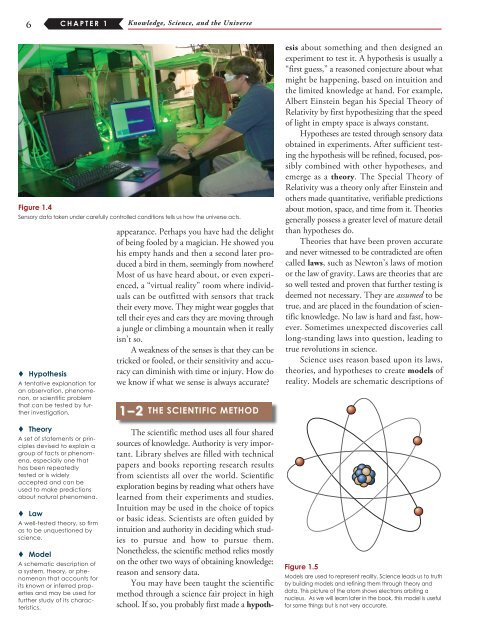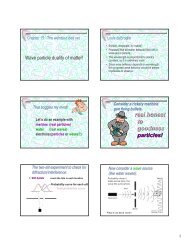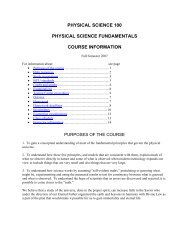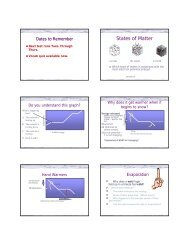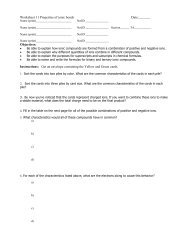knowledge, science, and the universe chapter 1 - Physical Science ...
knowledge, science, and the universe chapter 1 - Physical Science ...
knowledge, science, and the universe chapter 1 - Physical Science ...
Create successful ePaper yourself
Turn your PDF publications into a flip-book with our unique Google optimized e-Paper software.
6<br />
C h A p T E R 1<br />
Knowledge, <strong>Science</strong>, <strong>and</strong> <strong>the</strong> Universe<br />
figure 1.4<br />
Sensory data taken under carefully controlled conditions tells us how <strong>the</strong> <strong>universe</strong> acts.<br />
hypo<strong>the</strong>sis<br />
A tentative explanation for<br />
an observation, phenomenon,<br />
or scientific problem<br />
that can be tested by fur<strong>the</strong>r<br />
investigation.<br />
appearance. Perhaps you have had <strong>the</strong> delight<br />
of being fooled by a magician. He showed you<br />
his empty h<strong>and</strong>s <strong>and</strong> <strong>the</strong>n a second later produced<br />
a bird in <strong>the</strong>m, seemingly from nowhere!<br />
Most of us have heard about, or even experienced,<br />
a “virtual reality” room where individuals<br />
can be outfitted with sensors that track<br />
<strong>the</strong>ir every move. They might wear goggles that<br />
tell <strong>the</strong>ir eyes <strong>and</strong> ears <strong>the</strong>y are moving through<br />
a jungle or climbing a mountain when it really<br />
isn’t so.<br />
A weakness of <strong>the</strong> senses is that <strong>the</strong>y can be<br />
tricked or fooled, or <strong>the</strong>ir sensitivity <strong>and</strong> accuracy<br />
can diminish with time or injury. How do<br />
we know if what we sense is always accurate<br />
1–2 ThE SCIENTIfIC METhOd<br />
The scientific method uses all four shared<br />
sources of <strong>knowledge</strong>. Authority is very important.<br />
Library shelves are filled with technical<br />
papers <strong>and</strong> books reporting research results<br />
from scientists all over <strong>the</strong> world. Scientific<br />
exploration begins by reading what o<strong>the</strong>rs have<br />
learned from <strong>the</strong>ir experiments <strong>and</strong> studies.<br />
Intuition may be used in <strong>the</strong> choice of topics<br />
or basic ideas. Scientists are often guided by<br />
intuition <strong>and</strong> authority in deciding which studies<br />
to pursue <strong>and</strong> how to pursue <strong>the</strong>m.<br />
None<strong>the</strong>less, <strong>the</strong> scientific method relies mostly<br />
on <strong>the</strong> o<strong>the</strong>r two ways of obtaining <strong>knowledge</strong>:<br />
reason <strong>and</strong> sensory data.<br />
You may have been taught <strong>the</strong> scientific<br />
method through a <strong>science</strong> fair project in high<br />
school. If so, you probably first made a hypo<strong>the</strong>sis<br />
about something <strong>and</strong> <strong>the</strong>n designed an<br />
experiment to test it. A hypo<strong>the</strong>sis is usually a<br />
“first guess,” a reasoned conjecture about what<br />
might be happening, based on intuition <strong>and</strong><br />
<strong>the</strong> limited <strong>knowledge</strong> at h<strong>and</strong>. For example,<br />
Albert Einstein began his Special Theory of<br />
Relativity by first hypo<strong>the</strong>sizing that <strong>the</strong> speed<br />
of light in empty space is always constant.<br />
Hypo<strong>the</strong>ses are tested through sensory data<br />
obtained in experiments. After sufficient testing<br />
<strong>the</strong> hypo<strong>the</strong>sis will be refined, focused, possibly<br />
combined with o<strong>the</strong>r hypo<strong>the</strong>ses, <strong>and</strong><br />
emerge as a <strong>the</strong>ory. The Special Theory of<br />
Relativity was a <strong>the</strong>ory only after Einstein <strong>and</strong><br />
o<strong>the</strong>rs made quantitative, verifiable predictions<br />
about motion, space, <strong>and</strong> time from it. Theories<br />
generally possess a greater level of mature detail<br />
than hypo<strong>the</strong>ses do.<br />
Theories that have been proven accurate<br />
<strong>and</strong> never witnessed to be contradicted are often<br />
called laws, such as Newton’s laws of motion<br />
or <strong>the</strong> law of gravity. Laws are <strong>the</strong>ories that are<br />
so well tested <strong>and</strong> proven that fur<strong>the</strong>r testing is<br />
deemed not necessary. They are assumed to be<br />
true, <strong>and</strong> are placed in <strong>the</strong> foundation of scientific<br />
<strong>knowledge</strong>. No law is hard <strong>and</strong> fast, however.<br />
Sometimes unexpected discoveries call<br />
long- st<strong>and</strong>ing laws into question, leading to<br />
true revolutions in <strong>science</strong>.<br />
<strong>Science</strong> uses reason based upon its laws,<br />
<strong>the</strong>ories, <strong>and</strong> hypo<strong>the</strong>ses to create models of<br />
reality. Models are schematic descriptions of<br />
Theory<br />
A set of statements or principles<br />
devised to explain a<br />
group of facts or phenomena,<br />
especially one that<br />
has been repeatedly<br />
tested or is widely<br />
accepted <strong>and</strong> can be<br />
used to make predictions<br />
about natural phenomena.<br />
Law<br />
A well-tested <strong>the</strong>ory, so firm<br />
as to be unquestioned by<br />
<strong>science</strong>.<br />
Model<br />
A schematic description of<br />
a system, <strong>the</strong>ory, or phenomenon<br />
that accounts for<br />
its known or inferred properties<br />
<strong>and</strong> may be used for<br />
fur<strong>the</strong>r study of its characteristics.<br />
figure 1.5<br />
Models are used to represent reality. <strong>Science</strong> leads us to truth<br />
by building models <strong>and</strong> refining <strong>the</strong>m through <strong>the</strong>ory <strong>and</strong><br />
data. This picture of <strong>the</strong> atom shows electrons orbiting a<br />
nucleus. As we will learn later in <strong>the</strong> book, this model is useful<br />
for some things but is not very accurate.<br />
+


